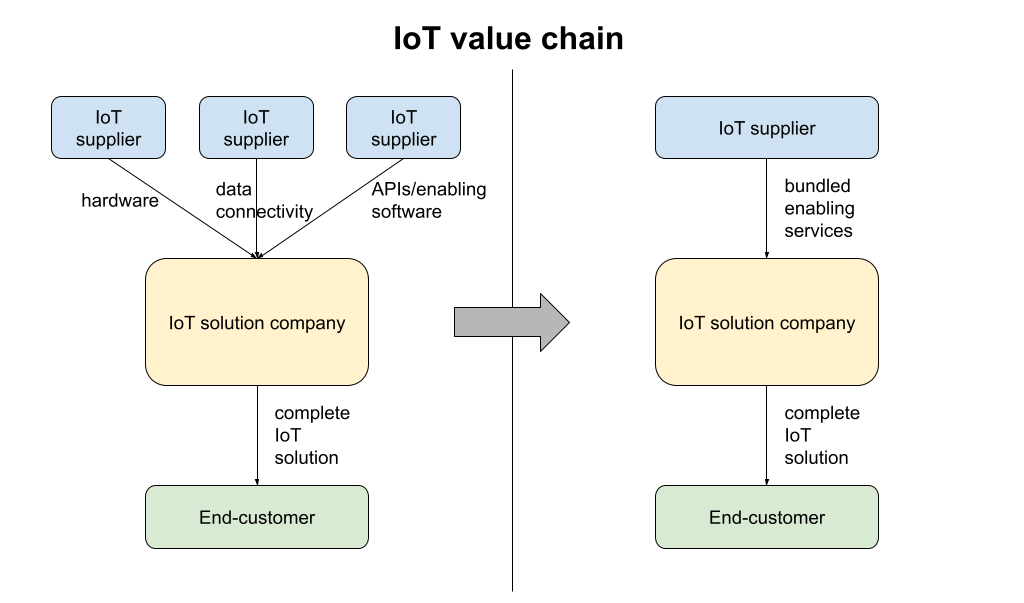Launching an innovative IoT solution starts with an obsessive focus on the future customer. Why will they use it? What will their experience be like? What are the features that will make it appealing?
Whether it’s an asset monitoring solution, a smart city application, or an industrial process optimization solution, the focus must be on the customer experience to maximize the chances of getting traction in the marketplace. This is a very important notion that should be embraced by the IoT suppliers who provide the enabling IoT components to the solution companies. Devices, connectivity services, software enablement solutions are not the front-and-center for the ultimate user. Those are the building blocks, which a skilled solution company will leverage to create a successful product. The more of those building blocks work well together, the easier it is for the solution company to focus on their customer-facing differentiators. This article makes an argument that offering bundled IoT services is an effective way to help solution companies get up and running faster and scale quicker.
Ensuring stickiness
A significant hurdle to the adoption of IoT has to do with the complexity of making various enabling components work together. Hardware devices are often difficult to configure. Depending on the connectivity operator, certain settings (such as APN) in the device have to be set up. To minimize the cost of an often expensive data connectivity service, useful payload is usually sent by a device in binary form, which requires decoding. When an IoT solution company gets confronted with these added challenges the progress on the core solution may slow down.
If, on the other hand, they were to work off of a pre-setup bundle with the pre-configured device, enabled connectivity, and easy API-based access to the device data, time to market could shrink considerably. As a result, if the new product finds demand, sales will scale, and along with them — device orders and activations on the data networks. IoT suppliers are clear beneficiaries.
Eliminating barriers
But benefits to IoT suppliers do not stop at increased sales volumes. Let’s take a hardware maker or distributor. When the initial interest in the device is generated, what typically follows is the shipping of a sample for testing along with a thick PDF document, which details the protocol and how to decode device data. A solution company now needs to pull the developer off of their core application and have them develop a script to transform device data into the format that can be consumed by that application. This is usually accompanied by stressful engagement with the supplier’s tech support team, as inevitable issues come up during the process (frustration on both sides tends to mount along the way). And all this painful work needs to be done in order to just be able to test the device, which may not ultimately fit the needs. Intensive resource investment in IoT supplier’s technical support may result in no business at all.
Instead, if that thick PDF could have been replaced by an accompanying API, through which JSON formatted data could be extracted, it would greatly simplify testing, adoption, and ultimately scaling. Add connectivity right out of the box to help minimize the integration effort, and you’ve given the solution company the ability to put most of their attention and resources into building their core application.
Accounting for financials
There is also an important financial consideration that should not be overlooked. For the IoT supplier, whose business model is based on one-time sales, such as pieces of hardware, bundling them with data connectivity and/or API service allows turning their one-time sales into recurring sales. Not only will this lead to an expanded profit margin and CLV (customer lifetime value), but will also help develop a stickier and closer relationship with their buyers. In the maturing and competitive IoT products and services environment, close relationships are a critical success factor.
Additionally, recurring revenue businesses are much more attractive to investors. If outside capital is needed to fund business operations and/or strategic expansion, introducing recurring sales into the business model will significantly increase the odds of getting funded.
***
“We are just as successful as our customers are” may sound like a cliche, but should really be taken to heart by every IoT supplier, whose goal is to build a sustainable business. Constant evaluation of customers’ (i.e., IoT solution companies’) priorities and pain points should be an important part of forming a business strategy.
As inevitably more IoT solution companies emerge with great ideas on how to deliver innovative products across verticals such as Smart Cities, Transportation, Connected Healthcare, Construction, and others, IoT suppliers must keep thinking about how to provide their services in a way that helps their customers minimize unnecessary distractions and keep the focus on their originally conceived solution. It’s clear to us at flespi that the amount of complexities an average IoT solution company is dealing with is overwhelming.
Leading with the bundled offering, which includes pre-configured devices, data connectivity, and API that works well together will set more IoT solution companies up for success. The ripple effect of that will be more successful IoT suppliers and overall IoT market expansion.
*The title is inspired by Clayton Christensen’s business bestseller “Innovator’s Dilemma”. It explores why many successful and innovative companies while seemingly doing everything right ultimately fail.
